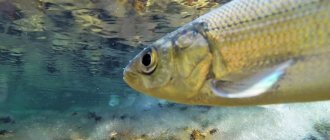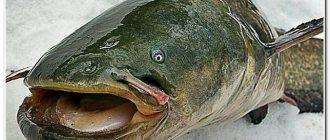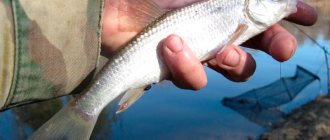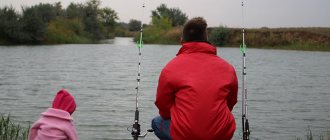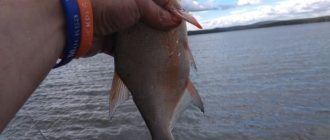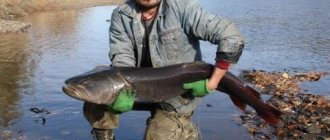An indigenous inhabitant of fresh water bodies in North America, channel catfish appeared within Russian borders back in the seventies of the last century. This representative of the Iktaluridae family is the most caught of the numerous commercial species of catfish that live on the North American continent; in our country, the southern regions, as well as specialized ponds formed at thermal power plants, have become habitats for fish.
This publication will tell you about its structure, habits and characteristics of life.
Natural habitats
Found primarily in subtropical latitudes, the American channel catfish is extremely thermophilic and thrives in water bodies with a water temperature of 25-28˚C. Apparently, these features contributed to the colonization of warm freshwater lakes, which are abundant in the central regions of America and northern Mexico. Like other species of catfish, the channel catfish reaches very impressive sizes, but clearly does not reach the giants that the common or river catfish can be. The average size of channel catfish is no more than one and a half meters in length and 5-9 kg in weight. But this fish is well cultivated in artificial ponds and pools.
Catching channel catfish
Channel catfish is a large, heat-loving freshwater fish of the Iktaluridae family. The Russian folk name is cat fish, which it received thanks to its large mustache. The channel catfish is native to North America. It came to Russia in the early seventies of the twentieth century in Kuban, from where it gradually settled in many warm-water reservoirs. It is a commercial species and is bred in many fish farms in various regions of our country.
The channel catfish is simply a graceful ballerina compared to the large and strong, but clumsy representatives of its family. Its body is the longest and slender among all catfishes, torpedo-shaped. Has no scales. The back of the channel catfish is dark, sometimes almost black, the sides are silver-gray with dark specks, and the belly is silver-white. The fins are colored in the color of the body, only their tips are sometimes dark. The head is medium in size, the snout is slightly flattened, the mouth is large. A distinctive feature of the catfish is its antennae, there are four pairs of them in total, the largest are in the corners of the mouth, smaller ones are on the lower jaw, and the smallest are near the nostrils.
In its historical homeland, channel catfish can grow up to one hundred and thirty centimeters, weigh twenty-six kilograms and live for almost a quarter of a century. Our catfish weigh no more than three kilograms and rarely reach a length of thirty centimeters; on average, our catfish weigh about five hundred grams and have a length of about twenty centimeters.
The channel catfish, like all catfishes, is omnivorous. He eats everything that falls into his mouth - fish, small animals like chicks or mice, insects and their larvae, crustaceans, frogs, when there is no animal food, he does not refuse plant food - algae, seeds. Channel catfish are lovers of deep holes and pools. The bottom prefers a clean, not silted, sandy or rocky, pitty and snagy bottom. Does not like standing water, prefers flowing water.
Read! Fishing for carp on the river
Channel catfish love warmth very much, so they are caught only in the warm period of the year. Channel catfish are strong and powerful, you need appropriate gear. The fishing line is thick and strong, the float is light sliding, the shank of the hook is long, the rod is strong. Like all catfish, it is a nocturnal predator, although it feeds most actively in the early morning and late evening. During the day, he will bite only if something tasty is very close to his predatory mouth. Catfish are best caught in warm weather with a water temperature of at least eighteen degrees and during the new moon. The full moon, cold weather and sudden changes in temperature and atmospheric pressure have a bad effect on the bite.
All winter - December, January and February, the heat-loving catfish sleeps in the deepest hole of the reservoir and does not react to any tasty bait.
In the spring it gets warmer, the catfish become more active and begin to feed. It's still cold in March, and he sleeps soundly in his hole. In April he wakes up and makes his first sluggish bite. In May it is already quite warm, the catfish is hungry after winter and is ready to actively feed. They catch it using bottom gear, spinning rods, and a circle. Bait - live bait, pieces of fish, worms, bloodworms, frogs, pieces of meat, cheese, dough, spinners.
Summer is the season for channel catfish fishing. All summer - June, July and August, the catfish is very hungry and extremely active. A variety of gear is used - a variety of bottom or float fishing rods, spinning rods, mugs. The bait is very different: live bait, a piece of meat or fish, a frog, a worm, dough, a spinner, some fans manage to catch a catfish even with a bar of soap.
In autumn, the catfish becomes sad. The colder the water, the sadder the catfish. In September, while it is warm and the weather is good, it bites almost like a summer fish. In October he is cold, he doesn’t want to feed, he is purposefully looking for a place to winter, but bites are still possible. Channel catfish fishing season is closed in November. The gear used in September is donks, spinning rods, and mugs. Baits include live bait, pieces of meat or fish, frogs, insects and their larvae, dough, spinners. In October, they mainly use bottom fishing rods with animal bait - fish, meat, frogs, worms.
Read! How to choose a PVC boat
Channel catfish is a very tasty fish, especially if you cook it skillfully. It is fried, boiled, baked, smoked and dried - this is a delicacy that is appropriate always and everywhere.
Channel catfish: breeding in artificial reservoirs
The Americans nicknamed it the catfish for its ease of “domestication” and high adaptive qualities to captivity conditions. Channel catfish grows very quickly, its meat is highly valued, it is tasty, tender and healthy.
Industrial breeding of this fish, which is today the main object of fish farms, has been carried out quite effectively in the USA for a long time. The fish is especially popular with American anglers because this aquaculture is widespread throughout the country and grows quickly and increases body mass.
Introduced to Europe in the 70s, channel catfish have successfully taken root in the basins of the Kuban and Don rivers, where today there is a stable population growth. Catfish are also bred in temperate latitudes - in ponds of fish farms in the Moscow region and the Ural region, located in close proximity to hydroelectric power stations and thermal power plants, which simultaneously heat water in reservoirs. Warm waters provide year-round comfortable development for fish.
Appearance and dimensions
As already mentioned, the channel catfish is significantly smaller than its river counterpart, its length can reach a maximum of one and a half meters, and its weight is 26 kilograms, however, these are the most record figures, and if you look at videos of catching channel catfish on the Internet, then fishermen usually come across much more small specimens.
In addition, these indicators are valid for Western countries, but in our country, due to the harsher climate, the size of this fish is even smaller, reaching an average of three kilograms.
However, this is enough for most fishermen, because the meat of this type of catfish is quite tasty.
In appearance, this fish, of course, most closely resembles its river relative. Brown in color with a naked, sometimes spotted body, and males usually have a darker body color.
After looking at several photos of channel catfish caught in different reservoirs and regions, you can see that many individuals also differ in the length of their whiskers and the shape of their dorsal fin.
The channel catfish itself comes from the west, from Canada and some states of the USA, where it is one of the most common types of catfish and is also eaten.
In 1972, this type of fish began to be artificially bred in the Kuban, after which it spread virtually throughout the entire country.
Oddly enough, harsh climatic conditions did not greatly affect the survival of the species, and only had an effect on the average size of the fish.Pond cultivation
When breeding this species, one of three methods is used: in aquariums, pool gardens or ponds. Pond farming is most often used as the simplest and most economical method, which does not require the purchase of expensive equipment, and labor costs are minimal. When choosing a site for constructing a pond, take into account the following features:
- topography of the area;
- quality and composition of soils;
- volume and quality of water.
The optimal depth for such a reservoir is considered to be 0.9-2 m on the southern side and 1.8-3.5 m on the northern side, where shallow water may freeze in severe winters. Reservoirs are stocked with fish in the spring, when the water has already warmed up to 13-15°C. At this time, the loss of fry is noticeably less than during the autumn release of fry. In addition, the “spring” fry immediately begin to grow rapidly. Despite the fact that the main food in such conditions is artificial food, the channel catfish receives a certain amount of food from the natural food supply of the pond.
Species features
Channel catfish are very similar in appearance to burbot. The color of the fish is uneven and spotty. The back is colored brownish-black or pistachio-gray, the belly is light, almost white, there are no scales, the body is naked.
Males are noticeably different from females. Their coloring is darker and therefore more pronounced, and their heads are shorter and wider. Adult females are plumper than males. In mature, older fish, the body coloring is also noticeably darker. Because of the spotted sides, the catfish received the name “channel”, which means “speckled” in translation. Albino catfish are also found in aquarium breeding. The head of the channel catfish is decorated with four pairs of antennae, located in pairs near the nostrils, at the corners of the mouth and on the chin. The fish is equipped with sharp, spiny fins. You should remember that the pectoral and dorsal fins of the fish are poisonous. When contacting her, do not forget to be careful.
The bulk of catfish grow to 0.5-0.7 m, reaching a weight of 4.5 to 9 kg, acclimatized ones - even less. For example, in the Don and Kuban, catfish weighing no more than 5 kg are caught. But history also knows record-breaking catfish: there is a known case when a channel catfish was caught in South Carolina, weighing 26 kg.
Channel catfish - fishing features
Catching channel catfish,
little known to most anglers.
So it lives mainly in the more southern regions of Russia and Ukraine. The historical homeland of the channel catfish is North America. At the end of the 19th century, this fish was brought from America to Western Europe, from where it quickly migrated to the reservoirs of the Russian Empire, mainly to the southern provinces. Today this fish can be found in the lakes of Belarus, Ukraine, in many ponds and canals of the Krasnodar and Stavropol territories, as well as in the Don, Akhtuba, and Lower Volga rivers.
Often this fish is grown in pond farms. In terms of its external characteristics, the channel catfish differs from its relative the common catfish. Its weight can reach 4 kg and its length is 65 cm. However, in its historical homeland of North America, its weight can be 8-12 kg and its length is more than 1 m. The skin of the catfish does not have scales; the pectoral and dorsal fins are spiny. There are round black spots throughout the body. The catfish has a large semi-lower mouth, the color of the sides and back is grayish-brown or greenish-brown. Spawning age occurs at 3-5 years, during this period the channel catfish reaches a length of 32-37 cm. Males, unlike females, have a wider and shorter head and a darker color.
Usually spawning in lakes and river backwaters, the spawning period begins in late April and can last until mid-July. During the pre-spawning period, stubborn fights often occur between males, which can result in serious injuries and even deaths. After a pair has been identified, the male chooses a place for the nest. Such places, as a rule, are located under the shore; the male carefully cleans the bottom of debris and silt.
In the case when the female is not ready to spawn, the male usually kicks her out of the nest. During the spawning process, the female lays eggs in several layers. The male fertilizes each layer of eggs separately. This process can take 6-12 hours. The masonry of the channel catfish is somewhat reminiscent of a formation similar to a sponge.
This fish is of particular interest for sport fishing. It is an omnivorous predator whose diet includes small fish, crustaceans, tadpoles, frogs, as well as a variety of insects and their larvae. Catfish can also feed on plant food.
Fishing for channel catfish
carried out with a wide variety of gear and methods. Usually they catch catfish using a donkey, a spinning rod and a float rod. Often good results are obtained by fishing on the track using a spoon or dead fish (on a tackle) as bait. A rig is a wire device onto which a hook with bait in the shape of a fish is attached. Such a device has existed for a long time; Sabaneev mentioned it in his works. The simplest tackle is a jig with live bait or a piece of fish attached to the hook, which is secured with thread or wire.
Channel catfish grab a tackle with a dead fish more readily than artificial bait. Usually, having grabbed a fish, the predator, unlike a spinner, does not immediately spit it out, and the fisherman has time for a quality hook. However, the hook should be stronger with the tackle than with the spinner.
Catching channel catfish
is carried out, it is possible using a variety of baits, live bait, cut fish, insect larvae and the insects themselves. Channel catfish are caught very well using caddis flies (shytik). Large caddis flies, which can be found in late spring or early summer, are better suited for bait. At this time, the caddisfly larva is at its maximum size.
Such larvae can be collected from reservoirs where there is running water. Usually they can be located on a sandy bottom or attached to branches of trees and bushes that have fallen into the water, as well as to the stems of reeds. In order to attach a caddisfly, the larva must be removed from the house and only then placed on the hook. The larva is inserted from the head to the tail. If catfish are caught using caddis flies, small hooks No. 4.5-6 are usually used. Channel catfish are excellently caught throughout the summer season; especially active catfish biting begins after the end of spawning.
If fishing for channel catfish
happens on a float tackle, it is best to catch this fish from the bottom. In this case, the hook with the nozzle should not just touch the bottom, but lie on the bottom. The float should be half submerged in water. This setting is very sensitive, and you can even see the slight touch of the fish on the bait. This method always brings excellent results if you fish from the bottom in places where there is flat, solid ground. For such fishing you need a short rod with a rigid tip and an equipped reel. As for the diameter of the fishing line, it must be selected depending on what kind of prey is intended to be caught. Typically this can be a fishing line with a diameter of 0.20-0.30 mm.
But when the wave is high, catching channel catfish
in this way is impossible, this is due to the fact that the sinker and bait begin to constantly twitch and thereby scare away potential prey. In this case, the float moves and long-cast fishing is already underway so that the sinker with the nozzle rests on the bottom. In this case, the sensitivity of the float decreases quite significantly. In this case, the angler will only be able to see a very active bite. In such situations, it is necessary to replace the sinker with a sliding and heavier one.
In spring, channel catfish can be caught without resorting to long casts. Usually the sinker is installed on a separate leash or sliding, the float is placed approximately 70 cm from the tip of the rod. After the cast has been made, the rod should be moved forward a little, this allows the bait and sinker to lie on the bottom, when the line stretches along it, the float descends into the water, next to the shore, where the current is calmer. After the cast is completed, the rod needs to be secured on the shore or on a special stand. And then prepare the next tackle for casting.
Typically, channel catfish fishing occurs with 3-4 rods, which are placed at a distance of 8-10 m, one from the other. As a rule, the channel catfish always grabs the bait confidently and greedily, sits securely on the hook, and exhibits stubborn resistance when fishing. It is recommended to remove the catfish from the hook with canvas mittens on your hands, otherwise there is a risk of injuring your hands on the prickly spines of the dorsal and pectoral fins.
Lifestyle
Channel catfish are a fast-growing predatory species. Young catfish live in mobile schools, but with age their lifestyle changes: they become solitary, adapting to living in a “staked out” territory.
These fish can be very aggressive, which is especially evident during the spawning period. Channel catfish need shelters - various snags, holes, and depressions. Preferring clean and deep places with a sandy or pebble bottom, the catfish leads a solitary lifestyle, showing enviable activity in hunting.
Spawning: preparation
The most important event in the life of any inhabitant of a reservoir is spawning. The channel catfish, a photo of which is presented in the publication, is no exception. In nature, catfish spawn from mid-April to July. He looks for and finds calm backwaters of rivers, small quiet lakes. Water that is optimal for spawning should be heated to 20-25˚C. Like many animals, spawning is preceded by aggressive fights organized by males. Often such fights end in injury, mutilation or even death of weaker opponents.
As soon as the pair has formed and the water in the reservoir has warmed up to the required temperature, the male chooses a secluded place, usually under the shore, and begins construction of the nest by thoroughly clearing the bottom of silt and various debris.
Masonry care
The female lays 2-3 layers of eggs in the prepared nest, each of which is immediately fertilized by the male, spending 4 to 12 hours on the entire process. The clutch is an elastic formation, visually similar to a sponge and consisting of bright orange round eggs tightly connected to each other. At the end of spawning, the male, like an exemplary father, begins to guard the eggs, and drives away the female. He takes the process very seriously and not only protects the precious clutch, but also shakes it from time to time with his fins, creating access for fresh water into the caviar layer. The eggs develop within 120-122 hours. Before hatching, the eggs darken and you can see hulking, mustachioed embryos in them, which the male continues to closely monitor.
He no longer shakes the eggs, but carefully fans them with his fins. When the eggs turn into embryos, their mobility is still very low, and they remain in the nest, forming dense, changing clusters. The embryos in these cluster clouds are positioned with their heads towards the center, and their tails are in constant motion. Nature is wise, and this placement allows the embryos to create internal vortex currents of water that wash away waste products and dead eggs. With age they become more active, but still stay near the nest. After 2-3 days, the larvae are already able to swim to the very surface of the water. At the same time, the swim bladder of the larvae is filled with air for the first time, and the pigmentation of the body intensifies, and the larvae acquire a gray tint.
Catfish larvae begin to feed on plankton already on the fourth day, and after a few more days they are already actively eating zoobenthos, minced sea fish, and combined feeds. Channel catfish fry grow very rapidly, quickly gaining weight.
Choosing a fishing rod
The channel catfish is a worthy opponent. Even two-kilogram specimens can offer the same resistance as a river pike weighing about 6 kg. And if fishing takes place near snags, then the tackle must be especially strong. Then it will be possible to keep a large individual from falling into a snag. For this, fishermen came up with two options for gear.
Rod for vertical fishing
Somyatniks use their usual fishing rod without a float.
- The rod is selected with high strength, which can withstand heavy loads when casting heavy equipment. The length of the form should be 5-7 m, with preference given to lighter modifications. This is explained by the fact that the tackle has to be held in hands for a long time. The test indicator should be in the range of 40-100 g.
- When choosing a spinning reel, you need to take into account the weight and power of the model. The spool must hold a good supply of fairly thick fishing line. For example, there should be 100 m of 0.28 mm line on the reel. As an alternative, fishermen use inertial models, the drum diameter of which will be within 120 mm. The advantage of old coils is their lower weight with the same power as “meat grinders”. In addition, simple reels are resistant to dirt and sand. The only drawback of the drum design is the lack of a friction brake. For this reason, you will have to hold the line with your finger when fishing.
- When fishing for channel catfish occurs at night, a “firefly” becomes a necessary element of the gear. It is attached to the tip of the rod using tape.
- Catching catfish with a fishing rod follows the following scheme. After casting the rig, a pause is made to allow the bait to reach the bottom. Following this, the fishing line is stretched so that the tip of the fishing rod bends slightly. A fish bite looks like a sharp movement of a telescope towards the surface of the water.
Bottom fishing rod
Bottom tackle looks a little different.
- The role of the fishing rod is played by a duralumin or fiberglass spinning rod with a length of 2.4-2.7 m. The test load should be from 60 to 120 g.
- It is more convenient to equip a bottom fishing rod with an inertia-free reel, then you will not have to periodically untangle the “beard” that inertial models tend to form.
- A fishing line with a diameter of 0.3-0.5 mm is wound onto the reel spool.
- When fishing for donks, you can’t do without rod stands. Since you often have to change the place of fishing, it is preferable to make a portable support made of stainless steel with a thickness of 6-8 mm. To do this, it is enough to sharpen the metal rod so that you can stick it into any bank without any problems.
- A bell is usually used as a bite alarm. It is better to tie it with a nylon thread to a fishing rod or stand so that after hooking it does not fly into the water.
Fishing
The hero of this publication is very interesting for sport fishing, because a true professional can only be captivated by such a strong opponent as the channel catfish. Fishing planet – fishing tournaments, popular in America and held there annually, have not yet become a tradition in Russia. Domestic fishermen today are still poorly acquainted with this aquatic inhabitant, since the distribution area of the heat-loving catfish is very limited. Nevertheless, the good adaptive abilities of the fish, rapid growth in artificial conditions and the excellent taste of the meat attract both entrepreneurs who organize pond breeding of catfish and fishermen who are already taking an active part in sport fishing competitions.

